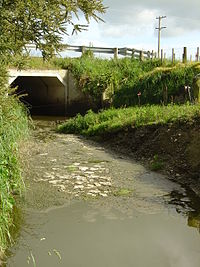
Photo from wikipedia
The effect of organic fertilizers on soil phosphorus (P) availability is usually mainly associated with the rate and forms of P applied, while they also alter the soil physical-chemical properties,… Click to show full abstract
The effect of organic fertilizers on soil phosphorus (P) availability is usually mainly associated with the rate and forms of P applied, while they also alter the soil physical-chemical properties, able to change P availability. We aimed to highlight the impact of pH and organic C modifications in soil on the inorganic P (Pi) sorption capacity and availability as compared to the effect of P accumulation after mineral or organic fertilizers. We conducted a 10-years-old field experiment on an andosol and compared fields that had been amended with mineral or organic (dairy slurry and manure compost) fertilizers against a non-fertilized control. Water and Olsen extractions and Pi sorption experiments were realized on soils sampled after 6 and 10 years of trial. We also realized an artificial and ex situ alkalization of the control soil to isolate the effect of pH on Pi sorption capacity. Organic fertilizer application increased total P, pH, and organic C in soil. Pi-Olsen increased mainly with soil total P (r2 adj = 0.79), while Pi-water increased jointly with soil total P and pH (r2 adj = 0.85). The Pi sorption capacity decreased with organic fertilizer application. Artificial and ex situ alkalization of the control soil showed that Pi sorption capacity decreased with increasing pH. Our study demonstrated that, beyond the P fertilization rate, the increase in organic C content and even more so in pH induced by a decade of organic fertilizer applications in soil decreased the Pi sorption capacity and consequently increased Pi-water in soil.
Journal Title: Chemosphere
Year Published: 2019
Link to full text (if available)
Share on Social Media: Sign Up to like & get
recommendations!